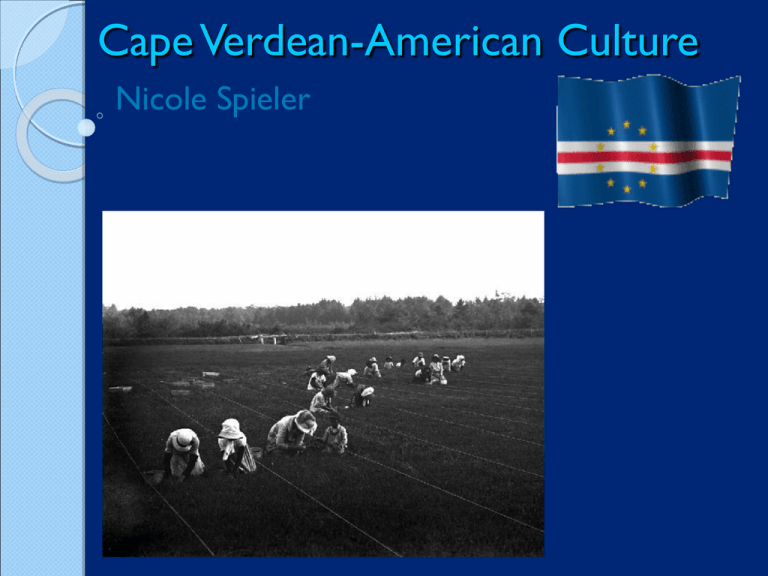see Artifact - Nicole E. Bartlett
advertisement

Cape Verdean-American Culture Nicole Spieler 21 Islands and Islets 9 Islands- Main body of Cape Verde History 1462 – A Portuguese explored visited uninhabited islands of Cape Verde and began to settle there 1501 – 1600 - Cape Verde is the shipping center for the slave trade 1701 – 1800 - U.S. whaling ships recruited crews from islands 1709 – 1807 - A minimum of 106, 544 slaves were carried in 934 known Rhode Island slave voyages 1773 – People started selling themselves as slaves onboard foreign ships due to one of the worst famines 1807 - U.S. formally prohibited slave trade 1832 – Severe famine caused ten percent of the population to die in Cape Verde History Continued 1863 – Famine again killed nearly a third of the population 1888 – Earliest attempt of a written alphabet 1917 – Newcomers required to demonstrate an ability to read and write by passing a literacy test administered by immigration authorities upon arrival 1920 – Another major famine killed about 30,000 people 1922 – Restrictions were introduced and emigration to America was reduced, it also deterred Cape Verdean Americans from visiting Cape Verde in fear of not being allowed back into the U.S. 1924 – Cape Verdeans harvested about nine-tenths of the Cape Cod cranberry crop 1930s – During the Great Depression an average of 50% of the Massachusetts and Rhode Island Cape Verdean labor force was unemployed History Continued 1966 – American Emigration rules relaxed and started to pick up pace again 1975 – Cape Verde islands finally gain independence from Portugal 1980 – U.S. Census made a “Cape Verdean” response for the question of ancestry 1982 – U.S. provided emergency humanitarian aid to the island in Brava after a hurricane 1995 – U.S. provided emergency humanitarian aid to the island in Fogo after a volcanic eruption 1995 – 1997 President and Prime Minister of Cape Verde visited Cape Verdean American communities in New England during official trips to the United States Values, Norms & Worldview FAMILY Connection to homeland Community relationships Identity Hard Workers Religion “Americanization” “There is some conflict present for them that may be due to the struggles to acculturate – that is, trying to ‘Americanize’ while confronted with familial, social, and peer pressure to adhere to the traditional Cape Verdean values and roles” (Andrade, 1996, p.99) Identity “The sufferings of drought and famine are central to Cape Verdeans’ sense of identity and have given them a view of their country as inextricable bound to poverty” (Carling, 2009, p.134). Census There is an estimated 300,000 to 500,000 Cape Verdeans living in the United States However, the 2000 Census only shows that there are 77,103 Cape Verdeans living in the United States. Massachusetts – 58.5% of Cape Verdean-Americans ◦ 17.6% living below poverty level ◦ New Bedford, MA – 10% 32.6% living below poverty level Rhode Island – 20.4% ◦ 20.7% living below poverty level Language Creole is the language used socially and informally between Cape Verdeans and is the preferred language to use by many Official Language of Cape Verde is Portuguese Quitodo “poor thing” Private family matter The word and concept of “disability” commonly used among service providers in the US is negatively perceived by Cape Verdeans, whereas the concept of “illness” or being “sick” is not and therefore preferred. Mental illnesses are seen as mysterious and the perception of someone who is depressed is that one should “cheer up” Interview Connection to Brava Escola Materna Nossa Senhora da Graça Counseling Interventions & Models Genogram Household Drawing / Eco-map Stress Management Indigenous Providers Multicultural Competence Four Forces Psychodynamic ◦ Difficult approach to take with someone who is Cape Verdean ◦ Highly Verbal ◦ Conscious about past and how it influences their present thinking, feeling, and behavior ◦ Internally looks at client ◦ Culture is not taken into consideration Four Forces Existential-Humanistic Approach ◦ Compatible in terms of religion and creating a safe environment ◦ Trust Needed ◦ Highly Verbal ◦ Not a direct route ◦ Lengthy Process – not open with counseling so this would impede in the process as well Four Forces Cognitive-Behavioral ◦ Focuses on observable behaviors and responses to life ◦ Short term ◦ Skill building ◦ Stress Management ◦ Client and counselor relationship critical for change Four Forces Multicultural ◦ Stresses how people develop multiple identities ◦ Context of culture, society and history into consideration ◦ Uses therapeutic strategies and techniques that effectively, respectfully, and ethically with people from diverse groups and backgrounds Do’s and Don’ts Do’s ◦ ◦ ◦ ◦ ◦ ◦ Be respectful, open, and non-judgmental towards client Discuss family and relationships Discuss their work/work ethic Discuss cultural events that they could attend Be aware of the differences between generations and gender roles Understand historical information Don’ts ◦ Do not press issues that they clearly are not comfortable discussing – trust might not get established if you do ◦ Refrain from asking directly why they came to counseling ◦ Make assumptions about history ◦ Do not exclude outside resources ◦ Do not use stereotypical terms New Bedford Whaling Museum Cape Verdean Maritime Exhibit (July 2011) ◦ This exhibition will capture the essence of the important connections between New Bedford and Cape Verde, the unique characteristics of Cape Verdean culture, and the special legacy of that culture and history here in New Bedford “It is hard to appreciate the value of life until you have come from a place like I have”




